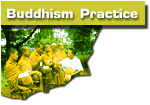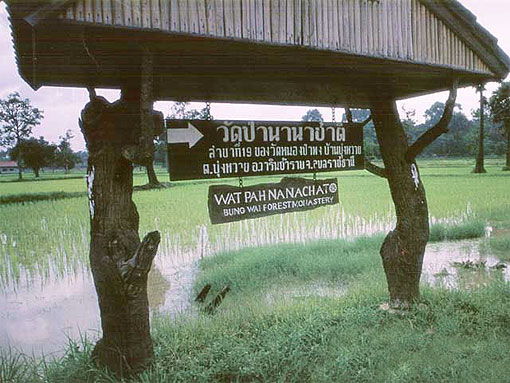 |
BANGKOK
|
||||||||
CENTRAL
|
||||||||||||
NORTHEASTERN
|
||||||||||||||
NORTHERN
|
||||||||||||
SOUTHERN
|
||||
 |
| A GUIDE TO MEDITATION CENTRES IN THAILAND |
| NORTHEASTERN - WAT PAH NANACHAT |
|
MEANING
OF NAME : |
"International forest monastery" |
ADDRESS
: |
Ban Bung Wai, Amper Warin Chamrab, Ubon Ratchathani 34310 |
WEBSITE
: |
http://www.watpahnanachat.org/ |
DIRECTIONS
: |
Located
outside the city of Ubon Ratchathani, about 600 km northeast of Bangkok.
From Ubon, go southwest 12 km to Ban Bung Wai on the highway to Si
Saket, then follow signs west one km through rice fields to the forest
and wat. You can take a Si Saket bus from Ubon and ask to be let off
at Wat Pah Nanachat or you can take a city bus 2 km south across the
Mun River to Warin and get a songtaew from the market area. Trains
arrive in Warin; walk 20 minutes east into town to catch a songtaew.
Easiest of all is just to take a tuk-tuk or taxi at the train or bus
stations or airport. Several fast trains provide daily service from Bangkok, including an overnight express which offers comfortable 2nd class sleepers. Many air-conditioned buses with reclining seats depart Bangkok's Northern ( Moh Chit ) Bus Terminal for the day or overnight journey. THAI offers a daily flight from Bangkok to the airport in the northern part of Ubon Ratchathani. |
MEDITATION
SYSTEM : |
No single technique predominates. One is creative, using a variety of appropriate meditations and reflections from the Theravadan tradition. Mindfulness with breathing forms the basis for most formal meditation. Teachers hold that samatha and vipassana cannot be separated. Sila, conduct of body and speech, along with monastic discipline forms a fundamental part of the training. One tries to maintain mindfulness in all postures. The monastery environment provides not only an ideal environment for meditation practice, but the opportunity to learn from and reflect on the customs and traditions honored here. |
TEACHING
METHOD : |
No formal instruction is offered. The teachers will answer questions. A library has a good selection of English and other foreign-language books on meditation practice. Some books about practice in the Ajahn Chah forest tradition are available by free distribution. Dhamma talks on audio tapes by Ajahn Sumedho and other teachers can be borrowed or copied. |
TEACHERS
: |
Ajahn Pasanno, abbot (Canadian; age 41) Ajahn Jayasaro, vice abbot (English; age 33) Senior monks teach men too. Women only meet with the abbot or vice abbot. Teachers usually talk with laypeople in the morning; the rest of the day is reserved for instructing monks and novices. |
LANGUAGE
: |
English is the medium of instruction. Most monks can speak some Thai and perhaps other Asian or European languages. The abbot and vice abbot speak fluent Thai; they give advice and Dhamma talks to local people much as abbots do at any monastery in Thailand. |
DESCRIPTION
: |
Nearly half of the 250-rai area (100 acres) is in thick forest. The main sala, where most of the Buddha images are, serves as the dining area and as the place for visitors to meet the abbot. Local villagers hold cremations at a site nearby. The bot has a marble and wood interior ofmodern design. A large meditation sala lies a 5-minute walk through the forest. |
SIZE
: |
monks
and novices 15-20 nuns 0 (no living quarters for nuns) laypeople 5-10 |
DAILY
ROUTINE : |
Group meetings and work periods have equal importance with formal meditation in the monastery. Laypeople are invited and expected to join the activities 3 a.m. wakeup; 330-515 a.m. chanting and meditation; 6-7 a.m.sweeping or help out in the kitchen (pindabat for monks, novices, and pakows); 8 a.m. offering food to the monks; about 830 a.m. the meal, followed by cleanup; 3-5 p.m. work period of hauling water, cleaning buildings, and other projects; 5 p.m. drink at abbot's kuti; 7-930 p.m. meditation, chanting, and Dhamma talk (or a reading). Other time is free for individual practice.The daily schedule changes during times of retreat and on Buddhist holy days ( wan phra ). On wan phra, the community and some visitors make the effort to stay up all night without lying down and practice meditation until 5 a.m. |
FOOD
: |
Very good quality and variety, including vegetarian dishes. Sticky, white, and (usually) brown rice are offered. Monks, novices, and pakows go on pindabat for rice; most food is donated to or prepared in the kitchen. Laymen and women with shaved heads eat with the monks. Other laypeople eat in the kitchen. Everyone adheres to the one-meal-a-day standard; a drink and sweets are usually offered in the afternoon. |
ACCOMMODATIONS
: |
Monks, novices, and laymen live in well separated kutis,most with a walking path. (Laymen visiting for short periods stay in a dormitory above the kitchen.) Women have their own building with individual rooms (can be shared) upstairs and western-style bathrooms downstairs. Men have communal facilities (bathing from tanks or showers; mostly Asian-style toilets). Bathrooms and large buildings generally have electricity and running water; kutis do not. Blankets and mosquito nets can be borrowed from the monastery. |
WRITE
IN ADVANCE? : |
Yes, be sure to write ahead with a request to stay, or you might be disappointed on arrival. The monastery can only accommodate a small number of guests. |
OTHER
INFORMATION : |
A visit provides a
great opportunity to experienceand participate in a monastic community
of the forest tradition. The way of life here will be unfamiliar
even to most visitors with a Buddhist background, hence animportance
of being willing to adapt and learn. For best results, plan on staying
a minimum of 1-2 weeks. If you're not keenly interested in the monastic
life-style or if you simply prefer doing your own retreat, other
places will be more suitable. Ajahn Chah established Wat Pah Nanachat in 1975 as a place where his western disciples could live and train in the Dhamma-Vinaya. Ajahn Sumedho, an American, served as the first abbot; after 2 years he went to England and founded monasteries there. Ajahn Pabhakaro, the second abbot, now assists with running the monasteries in England. Ajahn Jagaro then took over; he later established a monastery in western Australia just outside Perth. The current abbot, Ajahn Pasanno, has been in charge since 1982. Originally mostly westerners and the odd Thai trained at Wat Pah Nanachat. In recent years, however, a variety of Asians have added to the international atmosphere. Today the monastery is one of more than 100 branch monasteries in Thailand and around the world of Ajahn Chah's Wat Nong Pah Pong. |
| Select here : |
|
|
